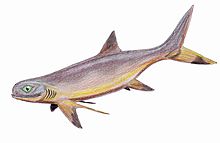| Symmoriiformes Temporal range: Late Devonian - Early Permian (Members of the family Falcatidae might have survived until the Early Cretaceous in Europe.)
| |
|---|---|

| |
| Symmorium | |
| Scientific classification | |
| Domain: | Eukaryota |
| Kingdom: | Animalia |
| Phylum: | Chordata |
| Class: | Chondrichthyes |
| Order: | †Symmoriiformes Zangerl, 1981 (sensu Maisey, 2007) |
| Families and genera | |
Symmoriiformes is an extinct order of stem-group holocephalians.[1] Originally named Symmoriida by Zangerl (1981),[2] it has subsequently been known by several other names. Lund (1986) synonymized the group with Cladodontida, while Maisey (2008) corrected the name to Symmoriiformes in order to prevent it from being mistaken for a family.[3] The symmoriiform fossils record begins during the late Devonian. Most of them died out at the start of the Permian, but Dwykaselachus is known from the Artinskian-Kungurian of South Africa.[1] Teeth described from the Valanginian of France[4] and Austria[5] indicate that members of the family Falcatidae might have survived until the Early Cretaceous; however, these teeth were also argued to be more likely neoselachian teeth.[6]
- ^ a b Coates M.; Gess R.; Finarelli J.; Criswell K.; Tietjen K. (2016). "A symmoriiform chondrichthyan braincase and the origin of chimaeroid fishes". Nature. 541 (7636): 208–211. doi:10.1038/nature20806. PMID 28052054. S2CID 4455946.
- ^ Zangerl, R. (1981). Chondrichthyes I – Paleozoic Elasmobranchii. Handbook of Paleoichthyology. Stuttgart: Gustav Fischer Verlag. pp. i–iii, 1–115.
- ^ Maisey, John G. (31 October 2007). "The braincase in Paleozoic symmoriiform and cladoselachian sharks". Bulletin of the American Museum of Natural History. 307: 1–122. doi:10.1206/0003-0090(2007)307[1:TBIPSA]2.0.CO;2. S2CID 85643864.
- ^ Guillaume Guinot; Sylvain Adnet; Lionel Cavin & Henri Cappetta (2013). "Cretaceous stem chondrichthyans survived the end-Permian mass extinction". Nature Communications. 4: Article number: 2669. doi:10.1038/ncomms3669. PMID 24169620.
- ^ Feichtinger, Iris; Engelbrecht, Andrea; Lukeneder, Alexander; Kriwet, Jürgen (2020-07-02). "New chondrichthyans characterised by cladodont-like tooth morphologies from the Early Cretaceous of Austria, with remarks on the microstructural diversity of enameloid". Historical Biology. 32 (6): 823–836. doi:10.1080/08912963.2018.1539971. ISSN 0891-2963. S2CID 92392461.
- ^ Alexander O. Ivanov (2022). "New late Carboniferous chondrichthyans from the European Russia". Bulletin of Geosciences. 97 (2): 219–234. doi:10.3140/bull.geosci.1845. S2CID 249479522.